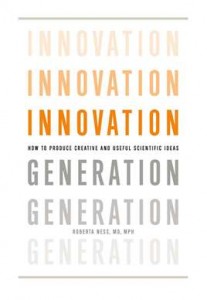“Innovation Generation: How to produce creative and useful scientific ideas” By Roberta Ness (Oxford University Press) $29.95

Reviewed by Paul Silvia, associate professor of psychology, University of North Carolina at Greensboro.
Some of science’s best ideas hide in plain sight: they seem obvious, even fatuous, but they have surprising implications. In the 1950s, J. P. Guilford, a founder of modern creativity research, wondered what would happen if he told some people to “be creative” while they were working on creativity tasks. He gathered a sample of adults and had them come up with unusual uses for common objects and write titles for short stories; half were told to try to come up with creative ideas. Not surprisingly, telling people to try to come up with creative, clever, and original ideas resulted in ideas that were much more creative, clever, and original.
This research sounds inane, perhaps, but it has surprising implications: if merely telling people to try to be creative makes their ideas better, then how much control do people have over the seemingly mystical process of creativity? Can creativity be learned or trained?
Enter Roberta Ness’s Innovation Generation: How to Produce Creative and Useful Scientific Ideas. A workshop in a book, Innovation Generation uses ideas from the study of creativity training to cultivate scientific innovation. The notion of training creativity might seem odd, but a lot of studies show that people can learn strategies and habits that cultivate creative thought.
Ness’s methods are distilled into the quirky acronym PIG In MuD:
• Phrase a question based on interest, observation, and knowledge. Instead of jumping aboard a faddish trend, people should choose a research problem based on their passion, experience, and expertise.
• Identify the frames and find alternatives. Making progress often depends on viewing a problem from a different angle. The problem of obesity, for example, is typically framed as a problem of personal willpower. Finding alternative frames—such as obesity as a problem of families and neighborhoods, not of individuals, or obesity as a result of the macroeconomics of food—will suggest provocative directions for new research.
• Generate all possible solutions. People tend to settle on the first idea that comes to mind because it feels intuitive and natural. But people should engage in divergent thinking, an approach that requires generating as many solutions as possible, including the implausible, unusual, and bizarre. Weird ideas serve as foils that throw the useful ideas into relief.
• Incubate. Taking a break from a problem and letting it simmer on the mental back burner seems to foster insights and creative breakthroughs. Cultivating hobbies and taking vacations are thus part of the innovation process.
• Meld your single best idea back into the process of normal science. Science has a lot of good ideas that don’t pan out. Researchers must thus evaluate their best idea using the methods and practices that other scientists in their field will find persuasive.
• Disseminate your innovative finding. An innovative idea won’t stick if people don’t hear about it. By cultivating public-speaking, writing, and sales skills, researchers can promote their innovation in the market of ideas.
The chapters walk the reader through these steps. Early chapters focus on identifying schemas, mental frames, and cognitive biases—the rut-diggers and boxmakers that make it hard to come up with fresh ideas. Later chapters describe how to overcome these constraints, formulate good questions, and develop an idea’s potential. And the end of the book discusses social and cultural aspects of innovation, such as attracting collaborators and persuading the field to adopt an innovation.
With its interesting stories and offbeat exercises for the reader, Innovation Generation has grab. But will the book make you more innovative? In the first chapter, Ness points out that her PIG In MuD approach is empirically grounded. With groups of science graduate students, the training program that inspired the book caused gains of 200 to 400 percent on standard assessments of creative thought.
Such findings make a scientist perk up, but readers will ultimately have to take Ness’s word for it. The book doesn’t describe her evidence or cite a paper that does, which seems like bad form for a book aimed at scientists who conduct research. Nevertheless, prior work on creativity training suggests that the ideas work—although probably not in the range of 200 to 400 percent—so the book would be a good way for a creatively thwarted scientist to spend a few inspiring evenings.
Roberta B. Ness (2012). Innovation generation: How to produce creative and useful scientific ideas. New York: Oxford University Press. 262 pp. $29.95.


